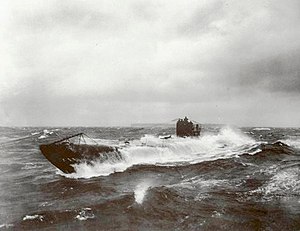 UB-148 at sea, a U-boat similar to UB-69.
| |
| History | |
|---|---|
| Name | UB-69 |
| Ordered | 20 May 1916[1] |
| Builder | Friedrich Krupp Germaniawerft, Kiel |
| Cost | 3,276,000 German Papiermark |
| Yard number | 287 |
| Launched | 7 August 1917[2] |
| Commissioned | 12 October 1917[2] |
| Fate | Sunk 9 January 1918 at 37°30′N 10°38′E / 37.500°N 10.633°E by British warship[2] |
| General characteristics [2] | |
| Class and type | Type UB III submarine |
| Displacement | |
| Length | 55.83 m (183 ft 2 in) (o/a) |
| Beam | 5.80 m (19 ft) |
| Draught | 3.67 m (12 ft 0 in) |
| Propulsion |
|
| Speed |
|
| Range |
|
| Test depth | 50 m (160 ft) |
| Complement | 3 officers, 31 men[2] |
| Armament |
|
| Service record | |
| Part of: |
|
| Commanders: |
|
| Operations: | 1 patrol |
| Victories: | None |
SM UB-69 was a German Type UB III submarine or U-boat in the German Imperial Navy (German: Kaiserliche Marine) during World War I. She was commissioned into the German Imperial Navy on 12 October 1917 as SM UB-69.[Note 1]
UB-69 was serving in the Mediterranean when sunk at 37°30′N 10°38′E / 37.500°N 10.633°E on 9 January 1918 by HMS Cyclamen. 31 crew members died in the event.[2]
Construction
[edit]She was built by Friedrich Krupp Germaniawerft of Kiel and following just under a year of construction, launched at Kiel on 7 August 1917. UB-69 was commissioned later that same year under the command of Oblt.z.S. Alfred Klatt. Like all Type UB III submarines, UB-69 carried 10 torpedoes and was armed with a 8.8 cm (3.46 in) deck gun. UB-69 would carry a crew of up to 3 officer and 31 men and had a cruising range of 9,090 nautical miles (16,830 km; 10,460 mi). UB-69 had a displacement of 513 t (505 long tons) while surfaced and 647 t (637 long tons) when submerged. Her engines enabled her to travel at 13.2 knots (24.4 km/h; 15.2 mph) when surfaced and 7.6 knots (14.1 km/h; 8.7 mph) when submerged.
References
[edit]Notes
[edit]- ^ "SM" stands for "Seiner Majestät" (English: His Majesty's) and combined with the U for Unterseeboot would be translated as His Majesty's Submarine.
Citations
[edit]- ^ Rössler 1979, p. 27.
- ^ a b c d e f Gröner 1991, pp. 25–30.
- ^ Helgason, Guðmundur. "WWI U-boat commanders: Alfred Klatt". German and Austrian U-boats of World War I - Kaiserliche Marine - Uboat.net. Retrieved 8 March 2015.
Bibliography
[edit]- Bendert, Harald (2000). Die UB-Boote der Kaiserlichen Marine, 1914-1918. Einsätze, Erfolge, Schicksal (in German). Hamburg: Verlag E.S. Mittler & Sohn GmbH. ISBN 3-8132-0713-7.
- Gröner, Erich; Jung, Dieter; Maass, Martin (1991). U-boats and Mine Warfare Vessels. German Warships 1815–1945. Vol. 2. Translated by Thomas, Keith; Magowan, Rachel. London: Conway Maritime Press. ISBN 0-85177-593-4.
- Rössler, Eberhard (1979). Die deutschen U-Boote und ihre Werften: eine Bilddokumentation über den deutschen U-Bootbau; in zwei Bänden (in German). Vol. I. Munich: Bernard & Graefe. ISBN 3-7637-5213-7.